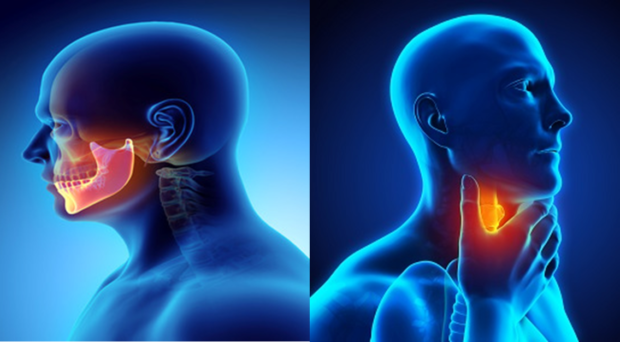Oral, Head and Neck Cancer Awareness Month: Research Highlights
BMC supports Oral, Head and Neck Cancer Awareness month in April with a focused campaign week starting April 7th, led by the Head and Neck Cancer Alliance. In this blog, our Editors highlight some of the recent developments and emerging research areas on oral, head and neck cancers. This year, we’ve also created a quiz to complement these highlights and our author blog addressing Commonly Held Myths of Head and Neck Cancers .
Michelle Feng He 8 Apr 2019
(left) © yodiyim / stock.adobe.com; © nerthuz / stock.adobe.com (right)
Head and neck cancer accounts for 5–10% of all cancers in the United States and Europe. Oral, head and neck cancers are categorized by where they originate: either in squamous cells that line the head and neck or in the salivary glands. These cancers are then again subcategorized by the physical anatomy of where the cancer resides. An even more unique distinction is a sub-classification of head and neck cancers that is defined by an infection, Human Papillomavirus (HPV)-initiated oropharynx cancer. These HPV-associated cancers represent a different disease with different etiology, treatment tactics, and molecular profiling. This field of research is moving rapidly with new discoveries and challenges. We intend to impact the direction of research and clinical care in oral, head and neck cancer.
Below is a collection of recent articles, categorized by approaches and subtype topics, from our open access journals: Applied Cancer Research , Biology of Sex Differences , BMC Cancer , Cancer Cell International , Cancer Imaging , Cancers of the Head & Neck , Cell Death & Disease , Clinical Epigenetics , Clinical Proteomics , Head & Face Medicine , Human Genomics , Infectious Agents and Cancer , Insights into Imaging , Journal of Experimental & Clinical Cancer Research , Journal of Hematology & Oncology , Journal of Otolaryngology: Head & Neck Surgery, Lipids in Health and Disease , Orphanet Journal of Rare Diseases , Radiation Oncology
HPV infections and cancers
Clinico-pathological features of oropharyngeal squamous cell carcinomas in Malaysia with reference to HPV infection
High-risk type human papillomavirus infection and p16 expression in laryngeal cancer
HPV-driven oropharyngeal cancer: current knowledge of molecular biology and mechanisms of carcinogenesis
Human papillomavirus genome variants and head and neck cancers: a perspective
Locally advanced high-risk HPV related oropharyngeal squamous cell carcinoma (OPSCC); have we forgotten it is a different disease?
Oral cancers Induction of ER and mitochondrial stress by the alkylphosphocholine erufosine in oral squamous cell carcinoma cells
Seven-CpG-based prognostic signature coupled with gene expression predicts survival of oral squamous cell carcinoma
Sex differences in patients with high risk HPV-associated and HPV negative oropharyngeal and oral cavity squamous cell carcinomas
Surface-enhanced Raman spectroscopy of blood serum based on gold nanoparticles for the diagnosis of the oral squamous cell carcinoma
Treatment of oral cancers during pregnancy: a case-based discussion
© alessandroguerriero / Getty Images / iStock
Prognostic assessments and biomarkers Extracapsular extension is not a significant prognostic indicator in non-squamous cancers of the major salivary glands
Nodal disease predicts recurrence whereas other traditional factors affect survival in a cohort of South African patients with differentiated thyroid carcinoma
Predictors of circulating INTERLEUKIN-6 levels in head and neck cancer patients
Prognostic implications of the phosphatidylinositol 3-kinase/Akt signaling pathway in oral squamous cell carcinoma: overexpression of p-mTOR indicates an adverse prognosis
Relation of baseline neutrophil-to-lymphocyte ratio to survival and toxicity in head and neck cancer patients treated with (chemo-) radiation
Roles of β-catenin, TCF-4, and survivin in nasopharyngeal carcinoma: correlation with clinicopathological features and prognostic significance
Salvage radiotherapy for recurrent hypopharyngeal and laryngeal squamous cell carcinoma (SCC) after first-line treatment with surgery alone: a 10-year single-centre experience
Survival and associated factors among patients with oral squamous cell carcinoma (OSCC) in Mulago hospital, Kampala, Uganda
The effect of 2D and 3D cell cultures on treatment response, EMT profile and stem cell features in head and neck cancer
Epigenetics, genomics, and high throughput technologies Integrated data analysis reveals potential drivers and pathways disrupted by DNA methylation in papillary thyroid carcinomas
Integrated genomic analyses in PDX model reveal a cyclin-dependent kinase inhibitor Palbociclib as a novel candidate drug for nasopharyngeal carcinoma
Novel insights into epigenetic drivers of oropharyngeal squamous cell carcinoma: role of HPV and lifestyle factors
X-chromosome association study reveals genetic susceptibility loci of nasopharyngeal carcinoma
Lifestyle habits and risk factors Compared characteristics of current vs. past smokers at the time of diagnosis of a first-time lung or head and neck cancer: a cross-sectional study
Investigating adherence to Australian nutritional care guidelines in patients with head and neck cancer
Thyroid cancer risk in airline cockpit and cabin crew: a meta-analysis
Risk assessments and diagnostics: imaging and screening Easily detected signs of perineural tumour spread in head and neck cancer
FDG-PET/CT pitfalls in oncological head and neck imaging
Genome-wide DNA methylation profile identified a unique set of differentially methylated immune genes in oral squamous cell carcinoma patients in India
Multimodality imaging of paragangliomas of the head and neck
The utility of MRI histogram and texture analysis for the prediction of histological diagnosis in head and neck malignancies
Clinical trials and immunotherapy strategies © vege / stock.adobe.com
3-weekly or weekly cisplatin concurrently with radiotherapy for patients with squamous cell carcinoma of the head and neck – a multicentre, retrospective analysis
A plea to provide best evidence in trials under sample-size restrictions: the example of pioglitazone to resolve leukoplakia and erythroplakia in Fanconi anemia patients
Carbonyl reductase 1 is a new target to improve the effect of radiotherapy on head and neck squamous cell carcinoma
Phase I/II trial of Durvalumab plus Tremelimumab and stereotactic body radiotherapy for metastatic head and neck carcinoma
Postoperative (chemo) radiation in patients with squamous cell cancers of the head and neck – clinical results from the cohort of the clinical cooperation group “Personalized Radiotherapy in Head and Neck Cancer”
Serum proteomic-based analysis identifying autoantibodies against PRDX2 and PRDX3 as potential diagnostic biomarkers in nasopharyngeal carcinoma
Targeting phosphoinositide 3-kinase (PI3K) in head and neck squamous cell carcinoma (HNSCC)
Ultrasound-guided percutaneous laser ablation for papillary thyroid microcarcinoma: a retrospective analysis of 37 patients
Therapeutic treatment options A new molecular mechanism underlying the EGCG-mediated autophagic modulation of AFP in HepG2 cells
Accelerated vs. conventionally fractionated adjuvant radiotherapy in high-risk head and neck cancer: a meta-analysis
Combating head and neck cancer metastases by targeting Src using multifunctional nanoparticle-based saracatinib
Effect of DACH1 on proliferation and invasion of laryngeal squamous cell carcinoma
Histone deacetylase inhibitors suppress aggressiveness of head and neck squamous cell carcinoma via histone acetylation-independent blockade of the EGFR-Arf1 axis
Trans-vaccenic acid inhibits proliferation and induces apoptosis of human nasopharyngeal carcinoma cells via a mitochondrial-mediated apoptosis pathway
Patient care and quality of life Feasibility and acceptability of combining cognitive behavioural therapy techniques with swallowing therapy in head and neck cancer dysphagia
Improving quality of life through the routine use of the patient concerns inventory for head and neck cancer patients: a cluster preference randomized controlled trial
Progressive resistance training in cachectic head and neck cancer patients undergoing radiotherapy: a randomized controlled pilot feasibility trial
Time abides long enough for those who make use of it

 All over the world people are helping spread these messages through thousands of activities. Join this month’s campaign by using the hashtag #OHANCAW.
All over the world people are helping spread these messages through thousands of activities. Join this month’s campaign by using the hashtag #OHANCAW.

Comments